February itinerary in Japan Day 2 (Hyogo prefecture)
(Thursday, February 24)
Table of contents
3. Tanba City Hall Kaibara Branch, Great Zelkova tree (Kinone bashi)
4. Oda Shrine / Takeisao Shrine
5. Former Hikami Junior High School Building
6. Kaibara feudal lord Oda clan former residence Nagaya-mon, Kaibara Domain Jinya
10. Sukyoji Temple (Takuandera Temple)
14. Kogoro Katsura dwelling site
1. Taiko Yagura
I had breakfast at the hotel and took a bus to Kaibara station. The bus I got on is as follows.
Depart Sasayamahoncho 9:12, Shinki Bus “bound for Tanba Medical Center”, arrive at Kaibara Station 9:42, fare Yen 720
The main purpose of Kaibara is to visit “Kaibara Hachiman Shrine”, a national important cultural property. It was my first visit to Kaibara. It was a fun city to walk around. When you go to Tanba Sasayama, I definitely want you to go to Kaibara.
First of all, I went to “Taiko Yagura”. It is less than 5 minutes walk from Kaibara station. “Taiko Yagura” was made around the same time with the Kaibara clan’s residence (1714). It was used for alarms such as time signals and fires.
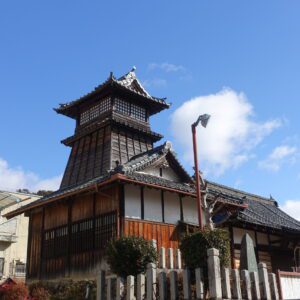
2. Kaibara Hachiman Shrine
The main shrine (main shrine and worship hall) of “Kaibara Hachiman Shrine” is a national important cultural property. It is said that it was founded by enshrining Susanoo-no-Mikoto during the time of Emperor Jomei (629-641). The current shrine was rebuilt by Hideyoshi Hashiba (Toyotomi) in 1585. The architectural style of the shrine is valuable as a pioneer of “Gongen-zukuri”. “Gongen-zukuri” is a construction method in which the main shrine and the worship hall are integrated and a lower building called “Ishi-no-ma” is installed between them.
Since “Kaibara Hachiman Shrine” is located on the summit of Mt. Irifune, you need to climb the stone steps to reach the shrine. On the day I went, some elderly people were slowly climbing the stone steps to worship. The shrine building has a wonderful appearance and I was impressed.
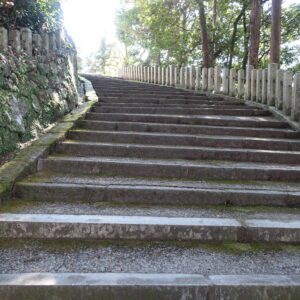
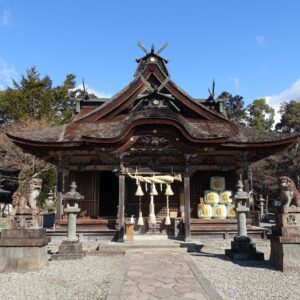
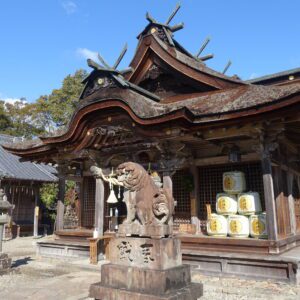
There is a three-storied pagoda in the precincts. There are only 18 towers in the shrine in Japan, and it tells the scenery at the time of Shinbutsu Shugo (Shinto-Buddhist syncretism) to the present day. The three-storied pagoda and the bell are important cultural properties designated by Hyogo Prefecture.
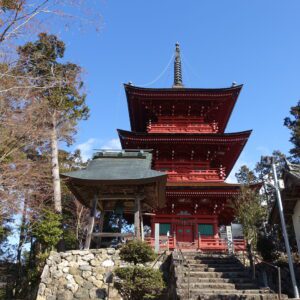
3. Tanba City Hall Kaibara Branch, Great ZeIkova tree (Kinone bashi)
At the foot of Mt. Irifune, where “Kaibara Hachiman Shrine” is located, there is “Tanba City Hall Kaibara Branch”. “Tanba City Hall Kaibara Branch” is a two-story wooden Western-style building built in 1935 as the former Kaibara Town Hall. I was intrigued by the yellow-colored building similar to the Former Hikami Junior High School building, which will be described later.
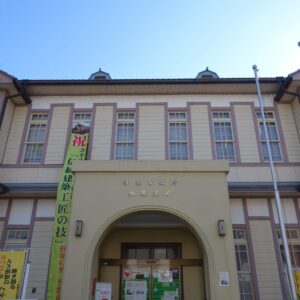
Right next to the Tanba City Hall Kaibara Branch, there is Great ZeIkova tree, a cultural property designated by Hyogo Prefecture and a natural monument. It is a giant tree estimated to be 1000 years old, and is also called a “tree root bridge” because it is a natural bridge with a length of 10 m.

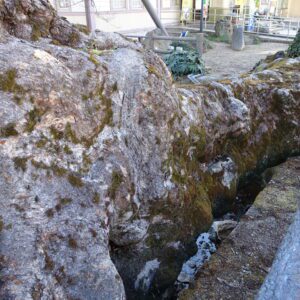
4. Oda Shrine / Takeisao Shrine
“Oda Shrine” is located near the Tanba City Hall Kaibara Branch, Great ZeIkova tree. “Oda Shrine” is enshrined as “Oda Gongen” by Nobukatsu Oda, the third feudal lord of the Kaibara domain. Nobukatsu is the younger brother of Nobunaga Oda and the grandson of Nobukane Oda, the first lord of the Kaibara domain. It’s a fairly simple shrine.
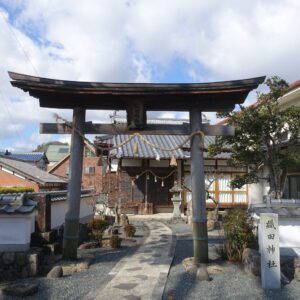
“Takeisao Shrine”, which is about a 5-minute walk from “Oda Shrine”, is a shrine whose deity is Nobunaga Oda. In Japan, there are only three “Takeisao Shrines” dedicated to Nobunaga Oda (Kyoto City, Kyoto Prefecture, Tendo City, Yamagata Prefecture). Like the Oda Shrine, it is a fairly simple shrine that makes us feel the rise and fall of the Oda clan, who once ruled Japan.
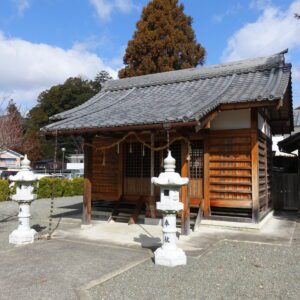
5. Former Hikami Junior High School Building
The Former Hikami Junior High School Building is a two-story wooden school building completed in 1885. It is an important tangible cultural property of Hyogo prefecture. Currently, it is used as a restaurant and library as “Tamba Reimeikan”.
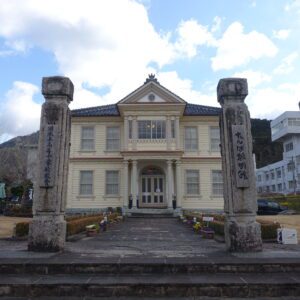
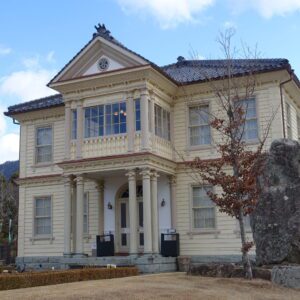
6. Kaibara feudal lord Oda clan former residence Nagaya-mon, Kaibara Domain Jinya
The Kaibara feudal lord Oda clan former residence Nagaya-mon was built in 1714. It is an Irimoya-zukuri. It is a cultural property designated by Hyogo Prefecture.
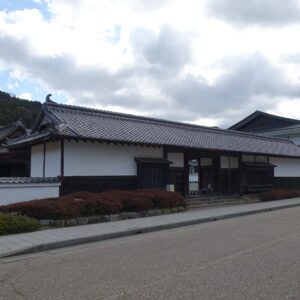
Passing through the Nagaya-mon, you will find the remains of the Kaibara Domain Jinya. The Kaibara Domain Jinya was built in 1714, just like the Nagaya-mon. It is designated as a national historic site as one of the few remains of Jinya in Japan.
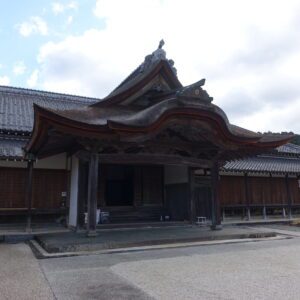
Admission: Adults Yen 210, junior high and high school students Yen 100, elementary school students Yen 50
It also serves as an admission ticket to the Kaibara History and Folklore Museum and the Den Sutejo Memorial Hall.
7. Shinkoro
After enjoying a walk in Kaibara, I went to Izushi. The public transportation I used is as follows.
Depart Kaibara Station at 11:23, Limited Express Kounotori No.5, arrive at Yoka Station at 12:24
Depart Yoka Station at 12:52, Zentan Bus “bound for Izushi”, arrive at Castle Town Izushi at 13:17, total fare Yen 3,260
The yellow limited express Kounotori was stopped at Kaibara Station. It has been in operation since August 2020, named after Fukuchiyama City, which was built by Akechi Mitsuhide, the main character of the 2020 NHK historical drama “Kirin ga Kuru”. Since it operates once a day, it seems to be a very valuable vehicle.

I also saw the yellow Shinkansen “Yellow Doctor” at Tokyo Station before. I’m pretty lucky.
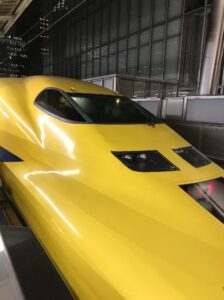
I got on the white limited express Kounotori.

There was a lot of snow at Wadayama station. There was a decaying old Wadayama locomotive warehouse at the end of the platform of Wadayama station. The former Wadayama locomotive warehouse was built in 1912 and has been used for over 80 years.
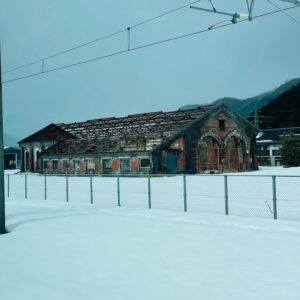
After arriving at Izushi, I had Izushi soba and went to the symbol of Izushi, Shinkoro.
Shinkoro was built in 1871 using waste materials such as the stone walls of the castle. It started operating as a clock tower on September 8, 1881. The Sapporo Clock Tower was in operation on August 12, 1881, so it is the second oldest clock tower in Japan. It is now a representative of the Toyooka City Izushi Traditional Buildings Preservation District (National Important Preservation Districts for Groups of Traditional Buildings). The origin of the Shinkoro is that it was a tower that hits the drum to inform the lord of the castle at the hour of the Dragon (7:00 to 9:00) at the beginning of construction.
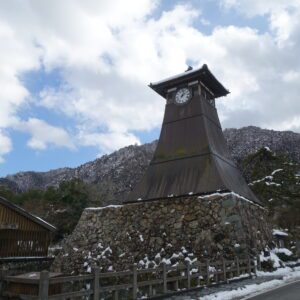
8. Izushi Castle Ruins
Izushi Castle is a few minutes walk from the Shinkoro. Izushi-jo is a castle that notified to the Tokugawa Shogunate in 1604 only the castle and pavilion as Izushi-jo at the foot of Arikoyama Castle. It was used as the domain office of the Izushi domain during the Edo period. The turrets located in the east and west were restored in 1968.
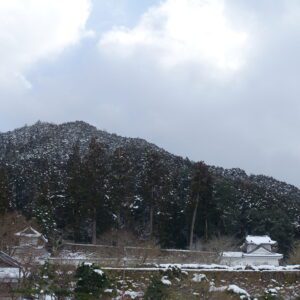
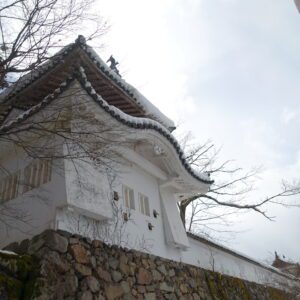
The stone wall of Arikoyama Castle still remains on the summit of Mt. Ariko. Arikoyama Castle was built in 1574 by Suketoyo Yamana, a leading guardian of the Muromachi period. In 1580, the castle fell under the attack of Hideyoshi Hashiba (Toyotomi).
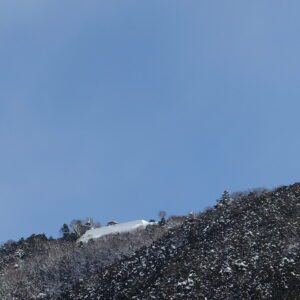
The Kannou-den at the site of Izushi Castle enshrines Hidehisa Sengoku, the first Sengoku clan who was the lord of the Izushi clan. Hidehisa Sengoku was the oldest vassal of Hideyoshi Toyotomi and served since he was a boy. Later, he also served the Tokugawa Shogun and became a Daimyo. There is also a tradition that he caught the great thief, Goemon Ishikawa.
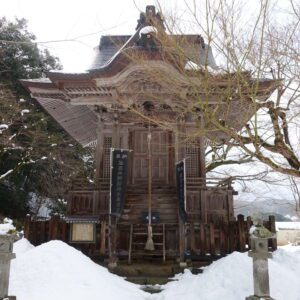
If you climb the east and west turrets and the Kannou-den on the stairs, you will find Arikoyama Inari Shrine. It was founded in 1604. There are 37 torii gates and 157 stone steps to the Shrine. It was snowy and it was difficult to climb up and down the stairs, but the shrine of Arikoyama Inari Shrine was wonderful and it was worth the effort to climb. The view of Izushi city from Arikoyama Inari Shrine was very beautiful.
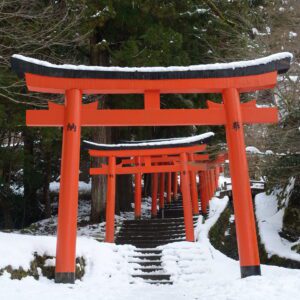
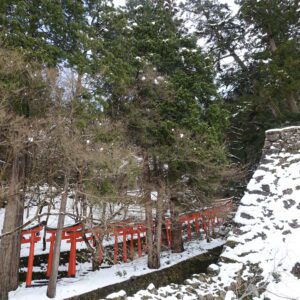
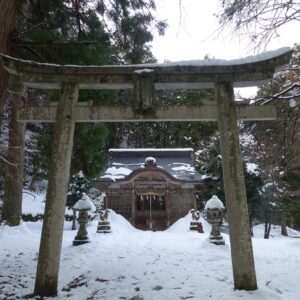
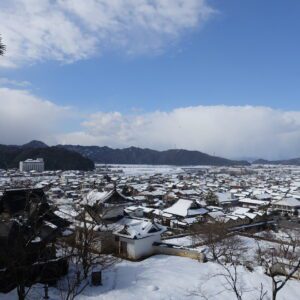
9. Meiji-kan
The Meiji-kan is a little less than 10 minutes walk from the Izushi Castle Ruins. The Meiji-kan is a county office built in 1887, and is a two-story wooden retro Western-style building. It is the only Western-style building in the Meiji era that remains in Izushi. It is a Western-style building that stands out because it feels quite strange in Izushi, which has an old Japanese atmosphere.
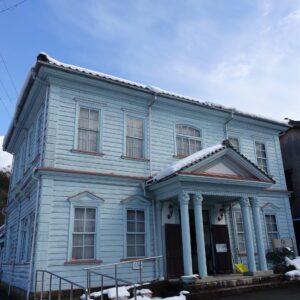
Admission: Yen 200 for adults, Yen 120 for high school and university students
10. Sukyoji Temple (Takuan-dera Temple)
Sukyoji Temple was built in 1392. It is called Takuan-dera Temple because it is the hometown of Takuan Osho (Buddhist priest). Takuan Osho was born on December 1, 1573 in what is now Izushi-cho, Toyooka City, Hyogo Prefecture. Takuan Osho’s father was Akiniwa Tsunaori, Yamana Suketoyo’s chief retainer. There are many folklore in Takuan Osho, such as inventing Takuan pickles and admonishing Miyamoto Musashi. At Sukyoji Temple, Takuan pickles are made and sold using the traditional method of Takuan Osho.
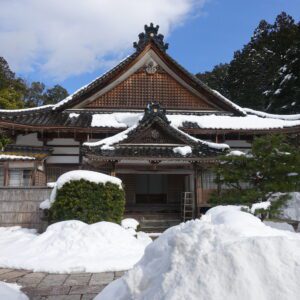

There is a memorial monument to Shonosuke Kawasaki (born in Izushi) at Ganjo-ji Temple, which is next to Sukyoji Temple. Shonosuke Kawasaki was the first husband of Yae Niijima, the main character of the NHK historical drama “Yae no Sakura”.
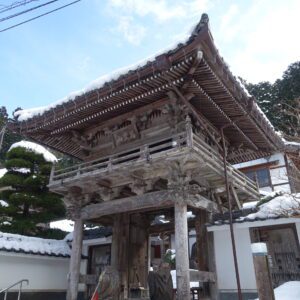

11. Izushi Sake Brewery
Izushi Sake Brewery, a historic sake brewery founded in 1708, is located a 5-minute walk from Sukyoji Temple and Ganjo-ji Temple. There is a red-walled sake brewery, which is rare for a sake brewery with many white walls. The representative brand of Izushi Sake Brewery, “Sasazuru,” is a nationally famous sake. Unfortunately, the day I visited was closed.
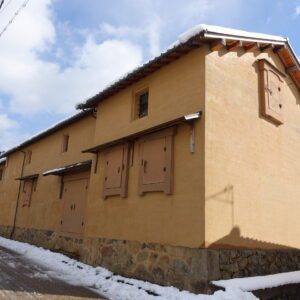
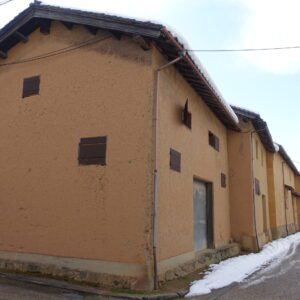
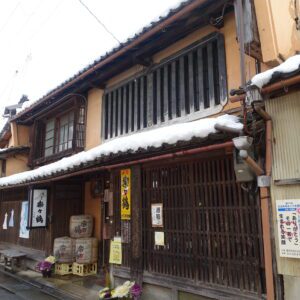
12. Former Fukutomi House
The main building of the former Fukutomi family residence, which was a wealthy merchant, was built in 1912. The main building is a two-story wooden townhouse building that still exists as it was when it was built. It is currently open to the public as the Toyooka City Izushi History Museum. Unfortunately I couldn’t visit the hall because I didn’t have enough time.
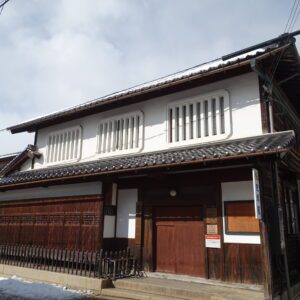
Admission: Yen 300 for adults, Yen 180 for high school and university students
13. Sakuraya
Sakuraya was rebuilt as a cafe and welfare-related facility from a Machi-ya (formerly Asai family residence) built in the Meiji era. The building is characterized by red-brown clay walls and red bengala such as doors.
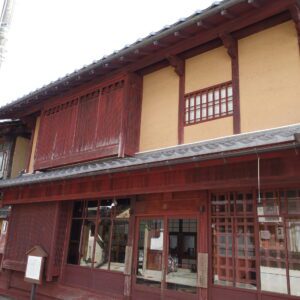
14. Kogoro Katsura dwelling site
Kogoro Katsura escaped from the Tokugawa Shogunate and was hiding for nine months in Izushi after the Kinmon Incident (1864). The site of the residence that used to run a household goods store is very close to the former Fukutomi family residence.
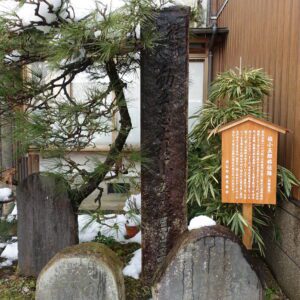
15. Oryu lantern
The lanterns at the landing place at the foot of the Izushi River bridge are called “Oryu lanterns”. It is said to be named after the main character “Oryu” in the tragic love story of the Kamakura period. “Oryu Lantern” is about a 5-minute walk from the Kogoro Katsura dwelling site.
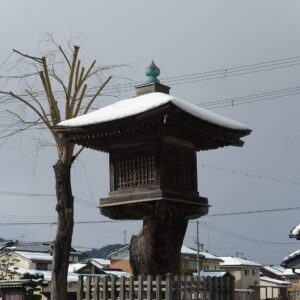
16. Eirakukan
Eirakukan is very close to the “Oryu Lantern”. Eirakukan was built in 1901. It is the oldest theater hut in the Kinki region and the oldest existing theater building in Japan. It is an important tangible cultural property of Hyogo prefecture. It was closed at the time of my visit.

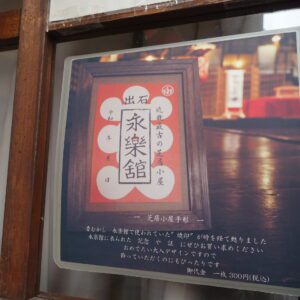
17. Hide Shrine
I took a bus from Izushi to Hide Shrine in Tanto-cho. The buses I used are as follows.
Depart Castle Town Izushi at 15:25, Zentan Bus “bound for Okufuji”, arrive at Hatayama at 15:52, fare Yen 750
Hide Shrine was built in the early 16th century at the end of the Muromachi period. The main shrine has been designated as a national important cultural property because it retains the architectural techniques of the late Muromachi period. The day I visited was deep in the snow and it was difficult to reach the shrine. It wasn’t a shrine that impressed me even though I had a hard time. I thought it would have been better if I could go sightseeing in Izushi more slowly without going to Hide Shrine.
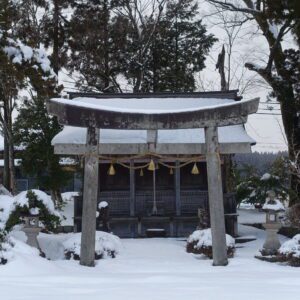
I returned to Izushi from Hide Shrine and went to Toyooka Station by bus. The buses I used are as follows.
Depart Hatayama at 16:32, Zentan Bus “bound for Izushi”, arrive at Castle Town Izushi at 17:00
Depart Castle Town Izushi at 17:25, Zentan Bus “bound for Toyooka Station”, arrive at Toyooka Station at 17:52, fare Yen 1,340
Note: The departure / arrival times, fares of transportation and admission fees, meal fees, etc. listed in the text are as of the time of writing the BLOG. Please check for yourself when you go on a trip as it may change in the future.